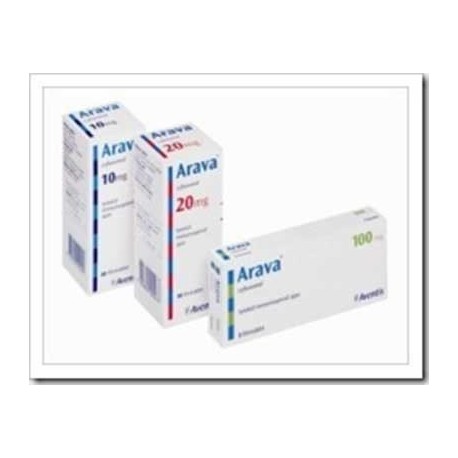 View larger
View larger Volume discounts
| Quantity | Discount | You Save |
|---|---|---|
| 2 | 5% | Up to $4.90 |
| 3 | 10% | Up to $14.70 |
| 4 | 15% | Up to $29.40 |
| 5 | 20% | Up to $49.00 |
More info
ARAVA 20 mg film-coated tablet To be taken orally.
Active ingredient
Leflunomide
Excipients
Lactose monohydrate (from cow's milk), corn starch, povidone, colloidal anhydrous silica, magnesium stearate, crospovidone, hypromellose, macrogol 8000, titanium dioxide, yellow iron oxide, talc.
1. What is ARAVA and what is it used for?
ARAVA belongs to the group of drugs used against rheumatism and contains 20 mg of leflunomide as an active substance.
ARAVA is white / yellow, film-coated, triangular and embossed with ZBO print. The tablets are available in plastic bottles containing 30 film tablets.
ARAVA is used in adults with active rheumatoid arthritis or active psoriatic arthritis.
Symptoms of rheumatoid arthritis are inflammation, swelling, difficulty in movement and pain in the involved joint. Other symptoms that affect the whole body are loss of appetite, fever, decreased energy and anemia (reduction in red blood cells, anemia).
Symptoms of active psoriatic arthritis include inflammation, swelling, difficulty in movement, pain, and patchy red scaly skin rashes (skin lesions) in the involved joint.
2.How to use ARAVA?
Always use ARAVA exactly as your doctor has told you. If you are unsure, consult your doctor or pharmacist.
The starting dose of Arava is usually 100 mg daily for 3 days. Following this initial period, most patients should increase to the following doses:
For rheumatoid arthritis: 10 to 20 mg of Arava once daily, depending on the severity of the disease.
For psoriatic arthritis: 20 mg of ARAVA once daily.
It may take 4 weeks or longer for you to feel an improvement in your condition. In some patients, this process may take up to 4-6 months. You should use ARAVA for a long time.
If you have the impression that the effect of ARAVA is too strong or too weak, talk to your doctor or pharmacist.
Application route and method
It is taken orally.
ARAVA tablets should be swallowed whole with plenty of water.
different age groups
Use in children
ARAVA is not recommended for use in children and adolescents under 18 years of age.
Use in the elderly
No dosage adjustment is required in patients over 65 years of age.
3. What are the possible side effects?
Like all medicines, there may be side effects in people who are sensitive to the substances contained in ARAVA.
If any of the following occur, stop using ARAVA and IMMEDIATELY inform your doctor or go to the nearest hospital emergency department.
Serious allergic reactions with symptoms such as weakness, lightheadedness, dizziness or difficulty breathing
Serious and sometimes life-threatening conditions with manifestations of skin rash or ulcers in the mouth (e.g. Stevens-Johnson syndrome (fluid-filled blisters in the skin, mouth, eyes and genitals, swelling of the skin and around the eyes, inflammation with swelling and redness), toxic epidermal necrolysis (a serious disease with fluid-filled blisters on the skin), erythema multiforme (usually spontaneous, hypersensitivity state that produces lace-like redness on the hands, face and feet), Eosinophilia and Drug Reaction with Systemic Symptoms -DRESS (starts with flu-like symptoms) and a rash that starts on the face and spreads, high fever, elevated liver enzymes in blood tests, and an increase in certain types of white blood cells in the blood (eosinophilia) and enlarged lymph nodes).
If you have one of these, you have a serious allergy to ARAVA. All of these very serious side effects are very rare.
If you notice any of the following, tell your doctor immediately or go to the nearest hospital emergency department:
Paleness of the skin, fatigue, bruises on the skin may be an indication of a blood disease due to an imbalance in the different cells that make up the blood.
Fatigue, abdominal pain or jaundice (yellowing of the eyes or skin) can be an indication of a serious condition such as liver failure, which can sometimes be fatal.
Signs of infection such as fever, sore throat or cough (ARAVA increases the risk of serious life-threatening infections).
Coughing or breathing problems, which may be a sign of inflammation of the lungs (interstitial lung disease) or high blood pressure in the blood vessels in the lungs (pulmonary hypertension).
Unusual tingling, weakness, or pain in your hands or feet, which may indicate conditions in the nerves of the arms and legs (peripheral neuropathy).
All these are serious side effects.
You may need emergency medical attention or hospitalization.
Side effects are listed as shown in the following frequency categories:
Very common: may occur in at least 1 in 10 patients.
Common: less than 1 in 10 patients, but more than 1 in 100 patients.
Uncommon: less than 1 in 100 patients, but more than 1 in 1,000 patients.
Rare: less than 1 in 1,000 patients, but more than 1 in 10,000 patients.
Very rare: less than 1 in 10,000 patients.

